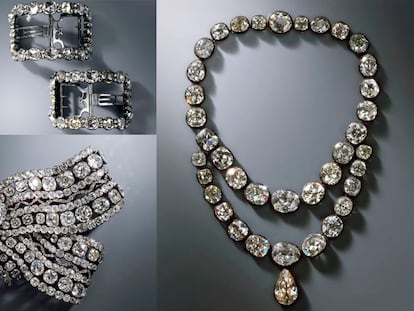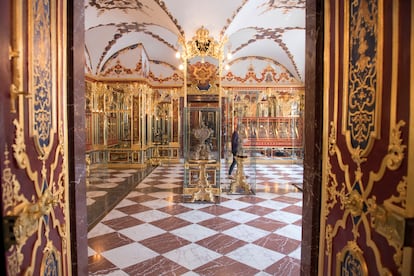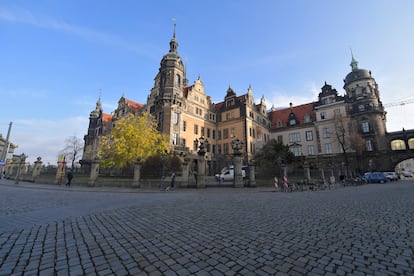Berlin thieves on trial for Dresden Palace heist return badly damaged diamonds
The six defendants accused of one of the most spectacular burglaries in recent years have given back some of the valuable 18th-century jewelry in an attempt to reduce their sentence. But much of it is broken and in pieces


The head of the Dresden museum spoke of a “Christmas miracle” when 31 fragments of the priceless collection from the Palace’s Green Vault turned up in mid-December. Twenty-one pieces had been stolen in a dramatic heist three years earlier, and there had been little hope of seeing them again as they were believed to have been melted down.
The miracle was an attempt by the alleged thieves, all members of the same Berlin-based mafia family, to get sentence reductions. The jewels were found scattered on the conference table of a law firm in the German capital while the lawyers representing the six defendants were negotiating a deal with the public prosecutor’s office. But what at first seemed to be excellent news for German cultural heritage has been tarnished by an analysis of the recovered pieces: most are damaged or fragmented. Moreover, it is precisely the most valuable ones that remain missing.
An expert witness testified at the trial on January 10 that one of the diamond-encrusted pieces had been broken into nine fragments. All bear traces of a whitish substance, probably the remnants of what was used to remove fingerprints. The diamonds appear cloudy and grayish in color, prompting the consideration that they were submerged in water for an extended period of time.

The judge at the Dresden Court of Appeals, where the six men aged between 23 and 28 are on trial, asked the restorer of the royal collection what it felt like to see the jewelry again. “It was very exciting,” she told the Frankfurter Allgemeine newspaper. But she also flagged up what remained lost, including the so-called Saxon White, a 50-carat diamond that cost as much as the construction of the Frauenkirche church in Dresden when it was bought in the 18th century; a sash studded with 650 diamonds and Queen Amalia Augusta’s necklace, which was fashioned from 32 diamonds. “They were the showpieces of the collection,” the restorer said.
The Green Vault is one of the richest treasure chambers in Europe, with a magnificently preserved collection of 18th-century gold, silverware and jewels, which, unlike other royal treasures, was kept together. Its most famous piece, the Green Diamond, was on loan to the Metropolitan Museum in New York at the time of the heist and so escaped abduction. Had it been in the poorly guarded and flimsy display cases of the royal palace in Dresden, it would also have ended up in the thieves’ hands.
Security camera footage, viewed at the trial, shows two hooded men entering through a palace window, which failed to trigger the alarms. Once inside, they broke into the display case with an axe, thereby accessing the 21 most valuable jewels in the collection. The operation was over in a matter of minutes, with the thieves making their getaway in an Audi A6 which they set on fire in a garage four kilometers from the palace, returning to Berlin in a different vehicle.

Although the lawyers for the accused were assured their clients would be acquitted, things have not being going according to plan for the members of the Remmo clan, a well-known criminal organization in Berlin. Despite the fact that they went to the trouble of filling the palace chamber with foam from a fire extinguisher, the police found traces of their DNA at the scene of the crime.
Naturally, the Dresden heist has raised many questions about the security of German museums. The thieves used an ordinary axe to break into the display case. They managed to trigger a blackout in the museum minutes before breaking in, simply by setting fire to a nearby electricity panel. A few days earlier, they had sawed through the bars of the window through which they entered, gluing them together to make them appear intact. Nobody noticed. They were arrested a year later, during an operation involving more than 1,000 police officers from all over Germany who searched several houses in the Berlin district of Neukölln, where the Remmo clan members live.
Four of the six defendants have shown a willingness to cooperate in exchange for reduced sentences. The deal proposed by the court requires not only the return of the jewelry, but also a blow-by-blow account of the planning that went into the heist and the role played by each member. For the those of the accused for which there is DNA evidence, the die would appear to be cast. However, one of the accused maintains he has an alibi and is refusing to plead guilty.

The whereabouts of the three most valuable pieces remains a mystery. Along with the Green Diamond, they were the stars of the collection built up by Augustus II The Strong, Prince of Saxony and King of Poland (1670-1733). Were they sold or are the Remmos holding onto them, believing them to be the ultimate trump card to avoid jail? The jewels may still be underwater. During the Christmas vacation, 22 police divers searched the Neukölln canal, but found little more than rusty bicycles.
With a total of 4,300 diamonds, the missing jewelry carries an insured value of almost €114 million besides being of immense cultural and historical significance for the Saxony region. As for the pieces that have been returned, the curators discovered that, besides most being in fragments, a jewel imitating a heron’s tail and the diamond-encrusted Polish Order of the White Eagle, while intact, are damaged, and it is not yet known whether they can be returned to their original state.
Sign up for our weekly newsletter to get more English-language news coverage from EL PAÍS USA Edition
Tu suscripción se está usando en otro dispositivo
¿Quieres añadir otro usuario a tu suscripción?
Si continúas leyendo en este dispositivo, no se podrá leer en el otro.
FlechaTu suscripción se está usando en otro dispositivo y solo puedes acceder a EL PAÍS desde un dispositivo a la vez.
Si quieres compartir tu cuenta, cambia tu suscripción a la modalidad Premium, así podrás añadir otro usuario. Cada uno accederá con su propia cuenta de email, lo que os permitirá personalizar vuestra experiencia en EL PAÍS.
¿Tienes una suscripción de empresa? Accede aquí para contratar más cuentas.
En el caso de no saber quién está usando tu cuenta, te recomendamos cambiar tu contraseña aquí.
Si decides continuar compartiendo tu cuenta, este mensaje se mostrará en tu dispositivo y en el de la otra persona que está usando tu cuenta de forma indefinida, afectando a tu experiencia de lectura. Puedes consultar aquí los términos y condiciones de la suscripción digital.
More information
Archived In
Últimas noticias
Most viewed
- Reinhard Genzel, Nobel laureate in physics: ‘One-minute videos will never give you the truth’
- Oona Chaplin: ‘I told James Cameron that I was living in a treehouse and starting a permaculture project with a friend’
- Pablo Escobar’s hippos: A serious environmental problem, 40 years on
- Charles Dubouloz, mountaineering star, retires at 36 with a farewell tour inspired by Walter Bonatti
- Why we lost the habit of sleeping in two segments and how that changed our sense of time










































